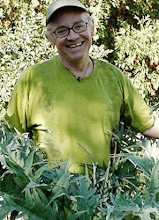


A cold frame is basically a box sitting on the soil with a transparent lid that will extend the growing season both in fall and spring. These season extenders have traditionally been used in a variety of ways by gardeners. I use them to grow greens, lettuce, and other cool weather crops throughout the year. These plans are for two frames from one piece of plywood and I have four frames in the garden this season - two for transplants and two for greens and lettuce.
Cold frames affect temperature by producing a micro-climate. This can be easily 10 to 20 degrees warmer than outside the box. The structure is commonly used to condition plants in a sheltered environment so they can then be moved to a permanent location. Season extenders can also be used to protect tender plants in the winter. The cold frame sits directly on the soil and the transparent lid should have the best south facing location possible. The sun will warm the soil and the plants and the absorbed heat will slowly be given off during the night. The nature of the sides and cover will help determine the heat retention of the enclosure. Because the lid is hinged this will allow easy access to the soil and a way to manage the temperature in the frame. Ventilation by lifting the lid is the most common way to manage the internal temperature of the cold frame. Some gardeners use temperature activated lift mechanisms to maintain the internal temperature but this can add to the total cost of the structure. The addition of foam insulation around the side of the cold frame can add to the heat retention, and some foam is foil backed which would add a reflective quality to the insulating.
The use of night covers can also promote a more favorable growing environment. However, such covers need to be easy to remove, should not absorb water, and be attached to make them windproof. These covers will need to be remove each day to allow for maximum light penetrating into the cold frames.
Cold frames affect moisture. High humidity helps protect plants from the effects of cold weather. Plus, spring and fall rains do not then drench to soil or pound young plants. However, the gardener will have to control the water provided to plants in these season extenders. The humid environment of the cold frame can soon turn into a desert if soil moisture is not managed. Hand watering is easily a trade off for more vegetables for a longer time. Additionally these structures also protect plants from wind. A wind chill factor will affect plants by removing heat and moisture. Plants in cold frames are protected from this fluctuation in their environment and as a result avoid this stress.
Cold frames can be purchased or built from a variety of materials. However, a word of caution about home built frames. Glass is not suggested in the construction of cold frames in our Wisconsin environment. Old storm windows are often used in cold frame construction, but they can easily shatter from heavy ice and snow creating a hazardous situation in the garden. There are many types of fiberglass and plastics that are a reliable substitute. Some materials can be purchased that are resistant to ultraviolet rays of the sun. Plastics are especially vulnerable to UV rays and will, in time, become quite brittle
The following post will have plans and measurements for home built cold frames.
Happy Gardening

hi there
ReplyDeletedoes the cold frame work by heating the soil, or the plants, or both?
I have some hanging tomato plants that I want to help out with extra heat. Should I cover the soil or just the plant with plastic?
thanks